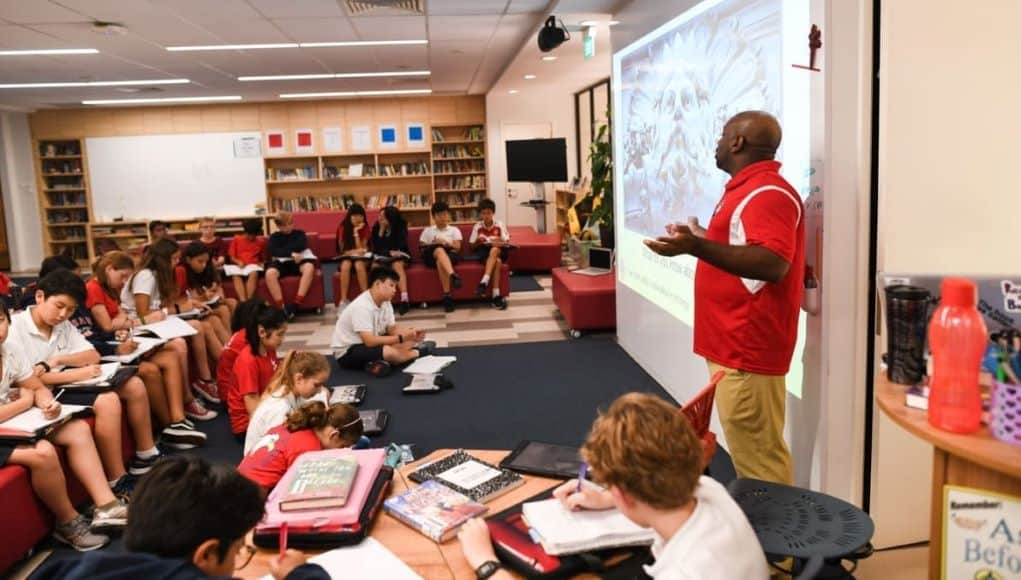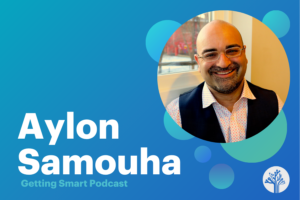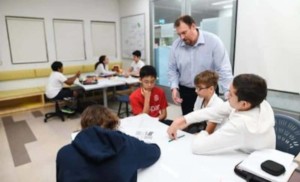Mythbusters: Flexible Learning in Middle School

This blog was originally published on Singapore American School’s Perspectives Blog.
MYTHBUSTERS: FLEXIBLE LEARNING IN MIDDLE SCHOOL
By: Lauren Mehbrach, Chris Beingessner, and Chris Raymaakers
In the fall of 2016, middle school began moving towards providing more personalization for our students through the use of flexible time and space, and implementing interdisciplinary units. Since then, we have worked to help our families understand what this looks like in action. We’ve heard there are some misconceptions out there. We hope to clarify some of them so that families can better understand the work of middle school, and how we’re responding to the changing world to better prepare our students for the future.
Myth #1: It’s all about the space
False. You may remember that last year we wrote a piece that discussed how physical space is just one component of a flexible learning environment. You can read more here about how flexible student grouping and time allocation are integral parts of providing more personal learning experiences within a flexible space. Whereas a renovated flexible learning environment makes these things significantly easier to do. We see these practices beginning to happen all across the middle school.

Over the past four years, we’ve replaced the traditional classroom furniture with more flexible seating options in almost every middle school classroom. Writing for Edutopia, middle school teacher Brooke Markle says, “Flexible seating is about more than simply having a variety of different, fun seats in the classroom. It’s about utilizing student voice, creating buy-in, heightening collaborative learning, and prioritizing students’ needs concerning the environment in which they learn.” In most of our middle school classrooms, our students have access to flexible seating options which allow them to choose what works best for them for a given task.
The flexible learning environments also have furniture that serves multiple purposes. For example, we have added whiteboard-topped tables to almost all of our classrooms. This helps students process their thinking visually, and gives teachers a way to more easily give feedback on student understanding and work. As one student noted, the whiteboard tables are “helpful with group work,” and “not wasting paper so it’s sustainable.” Portable shelves and TV projectors also enable students and teachers to display and access resources or work flexibly.
Myth #2: It’s an open, giant classroom.

False. We are not talking about the open classroom concept of the 1970s. Our newly renovated spaces in the middle school are designed to be able to serve many functions—hence the term flexible not open. Through small breakout rooms adjacent to classroom-sized teaching spaces, or moveable walls that allow a space to grow or shrink to accommodate different activities, the key is flexibility. If a teacher needs to conduct a small group lesson with half a dozen students, that space can exist. If a teacher needs all students assembled to hear a guest speaker, a space for that can exist as well. This aligns with the research out of New Zealand which found that “interior spaces need to be big enough for a range of learning activities, groups, and should be easily reconfigured.”
Myth #3: There are too many kids per teacher.
False. The student-teacher ratio in our learning communities remains the same as our standard classroom, which is 22:1. However, with multiple teachers in the space, efficiencies of time and skills are created. Imagine a single English classroom with 22 students. The teacher has assessment results that show that 6 of her students need further instruction on dialogue punctuation, five students need help identifying theme, and four students need to be pushed farther because they already learned what was assessed. In the traditional classroom, the teacher pulls each small group one after the other, meaning the remaining students are reading, writing or practicing independently.

Imagine now a collaborative learning community where two classes with two teachers come together during an agreed upon day and time to do some re-teaching and extension activities like the ones described above. One teacher might take a group of students who are learning how to punctuate dialogue in a piece of narrative writing. The other teacher takes the students who already know how to do that but need to learn how to develop characterization through dialogue, a more sophisticated application of the same skill, while the remaining students work independently on reading, writing, or grammar practice. After they finish those mini-lessons, one teacher might work with the group that needs support identifying theme, while the second teacher confers with individual students on their reading or writing. Often, the students in the collaborative space get more 1:1 or small group focused teacher time, not less.
In addition to being able to flexibly group students for more targeted instruction, teaching in a learning community has other benefits. As Paterson (2018) notes, “Learning is a social enterprise and people learn best in groups. Collaborative structures help to decrease teacher isolation, codify and share successful teaching practices, increase staff morale, and open the door to experimentation and increased collective efficacy.” Our parents have noticed this in action. As one parent put it, “The teaching seems better because they can leverage what works best from each other.” This collaboration results in richer, deeper learning experiences for students, as units of study are built on the collective expertise of all teachers, not the solitary practice of one.
Myth #4: The renovated spaces are unfair for introverts.
False. In purposefully designed flexible learning spaces, “cave spaces” for one to two students, small break out areas for groups of 3-10, and moveable furniture and partitions allow for a multitude of ways for the space to be used. In a traditional classroom, there are no breakout spaces, so students, introverted or otherwise, have no place to go for sound-isolated group or individual work. In the renovated spaces, there is more ability for our students to find a quiet place to work. In the feedback we’ve gathered so far from students, there’s not an appreciable difference in their perceived ability to find quiet space to work. Anecdotally, they’ve said they like the flexible space because they are able to find space away from other students when they feel the need. Additionally, students have designed many of our spaces which create nooks for more quiet thinking/collaborating. In many classes, all students are able to choose their seating and their work partners. This benefits both introverted and extroverted students as they can choose to sit at a “two top”, a “four top”, or a “six top” table. They can choose to be in the center of the action or in a more isolated space away from others. This isn’t possible in a traditional classroom.
Myth #5: It’s always loud.

False. There are times that all of our learning spaces—flexible or traditional—might seem loud, but there is a big difference between meaningless noise and the sound of students learning. The research about learning and the value of talk is clear. As Fisher, Frey, and Rothenberg (2008) outlined in their research on talk in the classroom, purposeful discussion supports students’ thinking, reflecting on their assumptions, and helps them construct understanding. Through purposeful talk, students are able to clarify their thinking, consider others’ points of view, and reflect and seek feedback. As a result, all of our teachers purposefully create opportunities for our students to talk, listen, and process with peers and adults in all of our classrooms. Singapore American School administration regularly conduct “Learning Walks” with our parents to help build understanding about the flexible learning spaces. Feedback like this from a parent is common, “I just wanted to say that I took the facilities tour yesterday, which took me into middle school. Wow. Great stuff! All my fears about 6A—noisy, chaotic, disruptive, incohesive—were quashed.” As another parent put it, “I was thinking it would be chaos, but it is really organized and friendly at the same time.”
Myth #6. They don’t even know if this works.
False. Part of implementing any change, whether it be in business or education, is collecting information to inform the change. The decision to move towards flexible learning environments was one of the results of a robust research and development process the school undertook between 2012-15. More than 75 faculty visited 100 schools over three years, while also conducting rigorous, in-depth research. The result was each division of the school created a set of research based recommendations that were endorsed by the school board. SAS is now on GettingSmart.com’s list of schools worth visiting, and they also highlight our change process and progress in Transforming Education from the Inside Out: Singapore American School. The work of SAS is also highlighted in the recent book, Learning by Design: Live, Play, Engage, Create by Nair, Doctori and Elmore.

When evaluating our implementation of the learning communities in middle school, we consider a number of sources of data. We gather feedback from teachers, parents, and students, including baseline data from students not in the learning communities. For example, after the most recent sixth grade exhibition in March, we gathered feedback from parents about their children’s learning experiences. We conduct regular focus groups with students about the furniture and their experiences in flexible spaces. We’ve done large scale surveys of kids in flexible learning environments at least twice a year. We also survey teachers twice a year, as well as have three 1:1 meetings each year with each faculty member to seek areas for improvement and document what is working well. We use a formal teaching and learning observation tool in the flexible spaces, having done more than 75 observations this year alone. In our observations, we speak directly with students about their learning so that we are capturing student experiences in their own words. Our MAP results are another data point that help us understand the needs of our students. We will continue to use these results, along with our student surveys, and student work to help us understand our opportunities for improvement.
We use this information to inform our practices. As part of our professional learning communities, teachers consider student data regularly. The data we collect from students in a flexible space helps teachers adjust their practice to better meet students’ needs. It also helps us reflect on the physical space design. In fact, we made changes to the physical layout of the 6C learning community over the winter break based on feedback about the noise level in the space. We solicit feedback, collect data, reflect on what we see, and make changes when warranted. What we are seeing is that students are more engaged in their learning, maintaining the high level of rigor of our academic program, and, as one student put it, “It’s more of a community….We have really good teachers, and I’m around people who like me.”
In conclusion, we know that this change is a tough one for people to fully comprehend and embrace. After all, we were products of a school environment nothing like this, and we think we turned out just fine! But, if we take a step back and don’t privilege our experience, the reality is that schools and offices around the world are beginning to design for collaboration and comfort. When we look back at photos of offices in the 1950s compared to offices of today, we see images like this:


We all have a common goal. We want our students to grow up to be successful adults, who are equipped for life in an ever-changing world. Our purposeful work to personalize learning for our students is enhanced within a flexible learning environment. Our teachers become better facilitators of learning within and across subjects when they work collaboratively and learn from one another. Our students become more active agents in their own learning, able to manage themselves and their work while developing the essential skills of collaboration, communication, critical thinking, creativity, and cultural competence through the skilled instruction of a team of teachers.
For more, see:
- Learning Environments for the Future: 4 Tips from Randy Fielding
- Podcast: Randy Fielding on Learning Environments for the Future
- https://www.gettingsmart.com/2018/12/top-education-trend-of-2018-active-learning-spaces/
Stay in-the-know with innovations in learning by signing up for the weekly Smart Update.







0 Comments
Leave a Comment
Your email address will not be published. All fields are required.